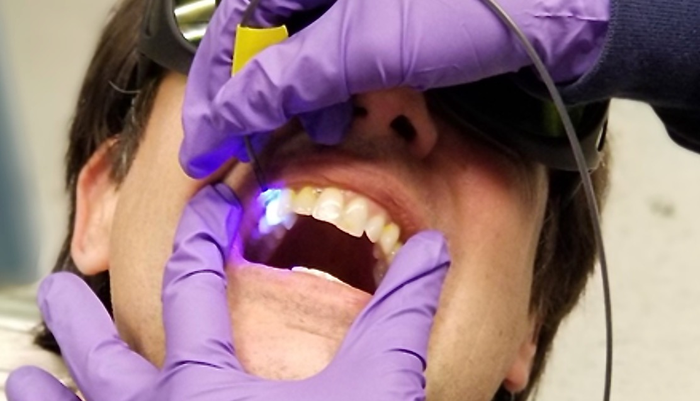New LED tool developed by scientists that spots dental cavities before they even start
Scientists hope to create version that shows exact location of high acidity on teeth

Scientists have developed a new tool that uses LED light to detect and measure specific chemical changes that lead to dental cavities, an advance that may lead to better ways of preventing the condition before it even starts.
The prototype tool is called the O-pH system and it measures the acidity built up by the bacteria in plaque that leads to cavities, according to a description of the device last month in the journal IEEE Transactions on Biomedical Engineering.
The device emits an LED light and measures its fluorescence with a US Food and Drug Administration (FDA)-approved chemical dye applied to the teeth.
Based on the light reaction, the optical device produces a numerical reading of the pH, or acidity, of the plaque covering those teeth.
This measurement can tell dentists and patients what area of a tooth is most at risk of developing a cavity, researchers said.
“Plaque has a lot of bacteria that produce acid when they interact with the sugar in our food,” Manuja Sharma, the study’s lead author and doctoral student at the University of Washington in the US, said in a statement.
“This acid is what causes the corrosion of the tooth surface and eventually cavities. So, if we can capture information about the acidic activity, we can get an idea of how bacteria are growing in the dental biofilm, or plaque,” Ms Sharma explained.
Since not all bacteria in plaque are bad or will lead to cavities, researchers said measuring the acidity of the environment can tell dentists what they need to know about the threat of developing problems.
They said such focus can limit the need to test for specific harmful bacteria, of which there will be large numbers on any given plaque.
For the study, scientists recruited 30 patients between the ages of 10 and 18, with a median age of 15, in the UW School of Dentistry’s Centre for Pediatric Dentistry.
Researchers said they chose children and teenagers for the study since the natural outer coating of enamel on their teeth is much thinner than that of adults, making it even more important for them to get an early warning of acid erosion.
They also recruited second- and third-year students in dentistry school, supervised by a faculty member.
“The study enrolled subjects with low (post-cleaning) and heavy (pre-cleaning) biofilm load, having both unhealthy/healthy surfaces,” scientists wrote in the study.
The idea of adding the acidity test as a new clinical procedure, scientists said, came from envisioning that when a patient first sits in the dental chair, before their teeth get cleaned, “a dentist would rinse them with the tasteless fluorescent dye solution and then get their teeth optically scanned to look for high acid production areas.”
In the test, researchers applied the dye to the teeth, and at the end of a length of cord they attached a probe that transmitted and collected light while hovering over the surface of a tooth.
This collected light then travels back to a central box that provides a pH reading that reveals the conditions on the patients’ teeth.
They repeated the test several times before and after sugar rinses and other condition changes such as pre- and post-professional dental cleaning.
Citing a limitation of the study, scientists said they were unable to consistently measure the same location on each tooth during each phase of testing.
They said they are currently making adjustments to the device to develop a version that produces images for dentists that instantly showed the exact location of high acidity, where the next cavity may occur.
“We do need more results to show how effective it is for diagnosis, but it can definitely help us understand some of your oral health quantitatively,” Ms Sharma said.
“It can also help educate patients about the effects of sugar on the chemistry of plaque. We can show them, live, what happens, and that is an experience they’ll remember and say, OK, fine, I need to cut down on sugar!” she added.
Join our commenting forum
Join thought-provoking conversations, follow other Independent readers and see their replies
Comments
Bookmark popover
Removed from bookmarks